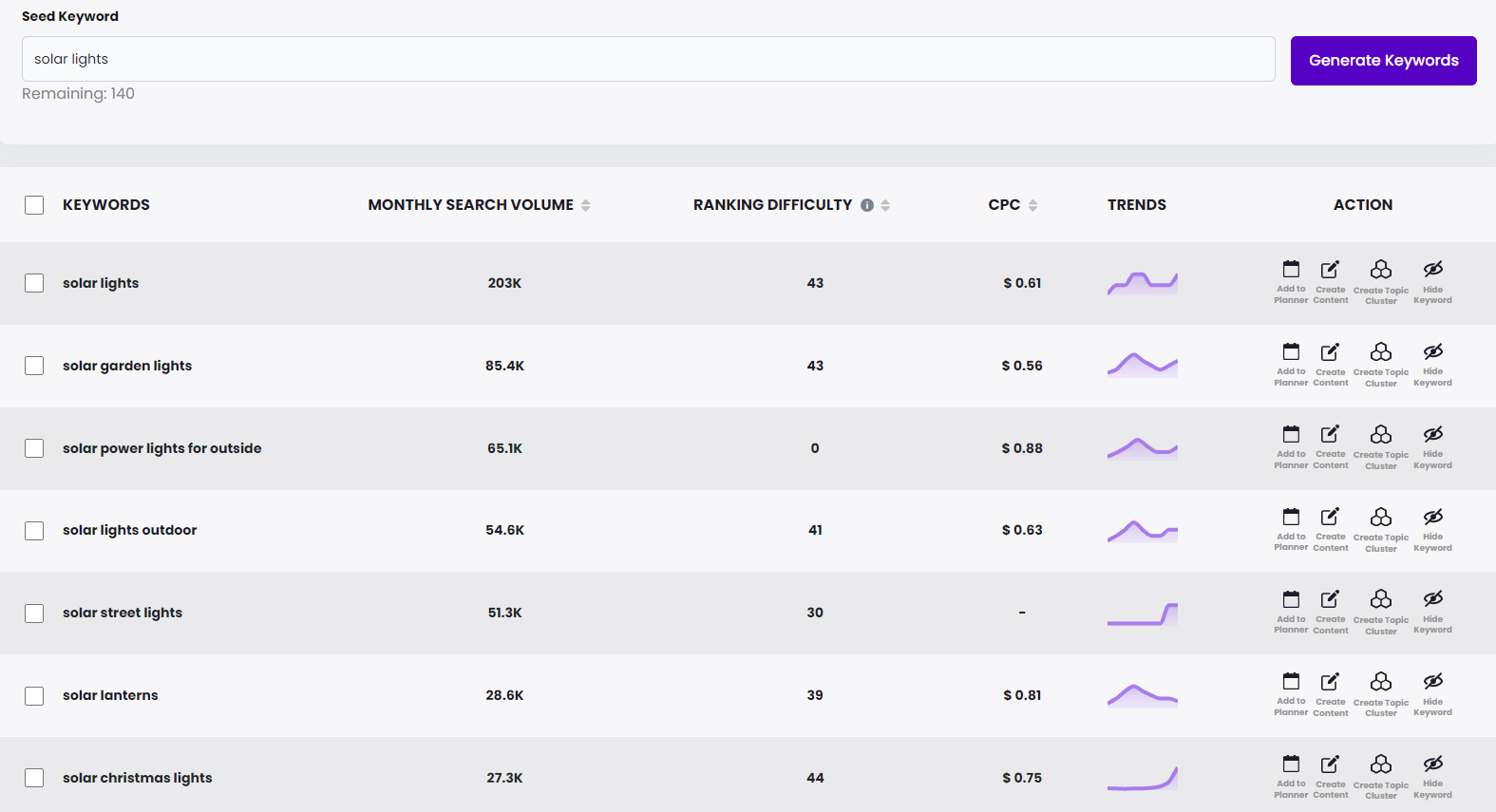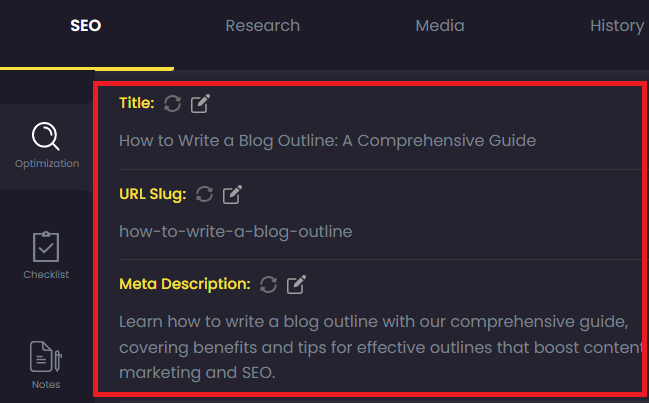Discover top guides, trends, tips and expertise from AIO Writers
How Do You Integrate SEO Into Your Content? Get Expert Tips
Julia McCoy
Tuesday, 14th May 2024
Pouring your heart into your writing only to have it go unnoticed is a frustrating experience that many creators can relate to.
The truth is, even the best content can get lost in the vast sea of the internet if it’s not optimized for search engines. But here’s the good news: integrating SEO into your content isn’t as complicated as it might seem.
By making a few strategic tweaks to your writing process, you can skyrocket your search rankings and attract more organic traffic to your site.
And the best part? You don’t need to be an SEO guru to make it happen.
How do you integrate SEO into your content? Let me show you.
Table Of Contents:
- How Do You Integrate SEO Into Your Content?
- Measuring the Success of Your SEO Content Strategy
- Amplify Your SEO Content on Social Media
- FAQs: How Do You Integrate SEO Into Your Content?
- Conclusion
How Do You Integrate SEO Into Your Content?
Search Engine Optimization (SEO) is what makes your content visible on popular search engines like Google.
Without a solid SEO content strategy in place, it can be a lot harder for your target audience to discover your articles organically.
The SEO content marketing process can be summed up in three steps:
- Keyword research
- Content optimization
- Building high-quality backlinks
Let’s start creating SEO-friendly content.
Step 1: Conduct Keyword Research
SEO content all starts with the crucial step of keyword research.
But before you start throwing in keywords left and right, there’s a method to the madness.
Identify Your Target Audience and Their Search Intent
First things first, you gotta know who you’re writing for and what they are looking for when they type a search query in Google.
What inquiries are swirling around in their head? What challenges are they grappling with day in and day out? What topics set their soul on fire and ignite their passion?
Answering these questions will help you identify relevant keywords and phrases to target in your content.
Find Relevant Keywords for Your Content Topics
When searching for the perfect keywords, try to find ones that are not only relevant but also specific to what your target audience is looking for. Long-tail keywords are a great way to match their search intent and attract the right visitors to your site.
Use keyword research tools to identify high-volume, low-competition keywords that you can realistically rank for. Then, incorporate these keywords naturally throughout your content.
Here’s an example of what a keyword report looks like (this was generated by BrandWell):

Incorporate Long-Tail Keywords Naturally
Long-tail keywords are more specific, multi-word phrases that tend to have lower search volume but higher conversion rates.
When incorporating them into your content, make sure to do so naturally, without sacrificing readability or user experience.
Use them in your titles, headings, and throughout your content where relevant.
But avoid keyword stuffing! Packing your blog posts with repetitive keywords can negatively impact your SEO efforts.
Keyword research is the backbone of creating content that not only ranks well but also speaks directly to your target audience. Skipping this crucial step is like building a house without a foundation – it might look okay at first, but it won’t stand the test of time.
Step 2: Optimize Your Content for Search Engines
With your target keywords identified, the next step is optimizing your content to ensure search engines can easily discover and prioritize it in relevant searches.
This is where you take your content from good to great in the eyes of Google and other search engines.
Craft Compelling Titles and Meta Descriptions
Think of your title and meta description as your content’s elevator pitch. In just a few words, they need to grab attention, communicate value, and make people eager to read more.
Make sure to include your target keywords in your title and meta description, but keep it natural and compelling.
You want to entice users to click through to your page.
If you’re using BrandWell to write your content, titles and meta descriptions will be automatically generated for you — with your primary keyword front and center.
In the example below, the main keyword is “how to write a blog outline” which you can see in the title, URL slug, and meta description.

Structure Your Content with Header Tags
Using header tags (H1, H2, H3, etc.) is crucial for both readability and SEO.
Breaking up your content into digestible chunks helps both users and search engines quickly grasp what’s most important. It’s like giving them a roadmap to easily navigate your site.
Use your primary keyword in your H1 tag and include related keywords in your subheadings to further optimize your content.
Optimize Multimedia Elements for SEO
Another important element of an effective SEO strategy is optimizing images and other visuals.
Optimizing means using descriptive, keyword-rich file names and alt text.
If you’re not using alt text on your images, you’re missing out on a key opportunity to improve your search engine rankings. Search engines rely on these descriptions to understand the content of your visuals, so make sure to include relevant keywords and phrases that accurately describe what’s being shown.
Plus, compressing your images to reduce file size can improve page load times, which is a big factor in both user experience and search engine rankings.
Ensure Readability and User Engagement
At the end of the day, your content needs to be easy to read and engaging for users.
Want to improve readability? Try using short paragraphs, bullet points, and subheadings to organize your content in a way that’s easy to follow.
The more engaged users are with your content, the better it will perform in search results.
Optimizing your content for search engines is an art and a science. It takes practice, but when you get it right, the results speak for themselves.

Step 3: Build High-Quality Backlinks
You’ve probably heard that backlinks are important for SEO. But what exactly are they and why do they matter so much?
Simply put, backlinks are links from other websites that point to your content. They act as a vote of confidence from other sites, signaling to search engines that your content is valuable and trustworthy.
Think of backlinks as the currency of the internet. The more high-quality backlinks you have pointing to your site, the more authority and credibility your content will have in the eyes of search engines like Google.
In fact, backlinks are one of the top ranking factors that Google uses to determine where your content should appear in search results. So if you want to improve your search rankings and drive more organic traffic to your site, building quality backlinks is essential.
Strategies for Earning Quality Backlinks
Don’t just reach out to webmasters asking for backlinks. You want to focus on earning high-quality, relevant backlinks from authoritative sites in your niche.
Here’s a pro tip: create content that’s so link-worthy that other sites can’t resist. Think in-depth guides that leave no stone unturned, original research that uncovers new insights, or thought-provoking op-eds that challenge the status quo.
When you give your audience something truly valuable, the backlinks will come naturally.
Find Guest Posting Opportunities
Another great way to build backlinks is through guest posting. This involves writing content for other relevant websites in your industry and including a link back to your own site within the post.
Not only does this help you reach a new audience and establish yourself as an authority in your niche, but it also provides a valuable backlink to your site. Just make sure you’re guest posting on reputable sites that are relevant to your industry.
Promote Your Content to Attract Links
Go ahead and shout your blog posts from the rooftops. Share them on social media, connect with influencers in your field, and even consider targeted ads to get your content in front of the perfect audience.
The more eyeballs you can get on your content, the greater the chances that other sites will take notice and link back to it.
Measuring the Success of Your SEO Content Strategy
Crafting search engine-friendly content is no easy feat, and building high-quality backlinks takes time and dedication. But after all that effort, how do you gauge whether your strategy is working?
Tracking the right metrics and KPIs is the key to unlocking those insights. You’ll discover what’s working, what’s not, and where you need to focus your efforts to crush your goals.
Set Key Performance Indicators (KPIs) for Your Content
The first step is to set clear, measurable KPIs that align with your overall business goals. These might include metrics like organic traffic, search rankings, click-through rates, engagement, and conversions.
By setting specific targets for each KPI, you can track your progress over time and make data-driven decisions to optimize your content strategy.
Track Organic Traffic and Search Rankings
One of the most important metrics to track is organic traffic — the number of visitors coming to your site from search engines like Google. Use tools like Google Analytics to monitor your organic traffic over time and see how it correlates with your SEO efforts.
Keeping tabs on your search rankings for target keywords is crucial. Tools like Semrush or Ahrefs make it easy to monitor your rankings and spot opportunities to boost your content’s visibility in search results.
Analyze User Engagement Metrics
Sure, traffic and rankings are crucial, but they’re not everything. Your content has to be the kind that grabs readers by the heartstrings — the sort of stuff that keeps them glued to the screen.
Track metrics like bounce rate, time on page, and pages per session to gauge how users are interacting with your content. If you notice high bounce rates or low engagement, it could be a sign that your content isn’t meeting the needs of your audience.
Amplify Your SEO Content on Social Media
Want to know my secret to get more eyes on my content?
It’s simple: get social.
By sharing your SEO content on social platforms, you can reach a wider audience and drive more organic traffic to your site.
But here’s the thing – you can’t just post and pray. You need a strategy. That’s where integrating your social media and content marketing efforts comes in.
Share Content on Social Platforms
Want to take your content marketing to the next level? Try incorporating SEO-optimized content into your social media posts to expand your reach and engage with a broader audience.
But don’t just copy-paste your blog post and call it a day. Tailor your content to each specific social media platform and include relevant keywords and hashtags.
For example, on Twitter, you can leverage trending hashtags to gain more exposure.
SEO Tip: Social signals contribute to search engine rankings. So the more engagement your content gets on social media, the better it can perform in search results.
To boost your SEO and drive more organic traffic, add social sharing buttons to your website or blog posts. It’s a simple way to encourage engagement and get your content in front of more people on social media.
Build Links Through Social Media
Social media platforms are a gold mine for link building, and sharing optimized content on these sites can skyrocket your SEO success. Reach a broader audience, generate more backlinks, and watch your rankings soar.
But it’s not just about posting and hoping for the best. Actively engage with your followers and industry influencers on social media. This can lead to natural link placements and collaborations.
Content is fire. Social media is gasoline. #smm #contentmarketing
— Jay Baer (@jaybaer) March 5, 2014
FAQs: How Do You Integrate SEO Into Your Content?
How to use SEO in content creation?
To weave SEO into content, start by identifying keywords that your target audience searches for. Then, craft engaging titles and headers sprinkled with these keywords. Ensure your posts are readable and peppered with internal links to keep readers hooked.
How do you apply SEO best practices to your content?
Apply SEO best practices by creating quality content focused on user experience. Use relevant long-tail keywords naturally within the text. Optimize images with alt tags and structure your post with clear headings. Finally, encourage sharing on social media to boost visibility.
How do you integrate SEO keywords?
To integrate SEO keywords effectively, sprinkle them throughout your content strategically — title, headers, and intro without overstuffing. Also, include them in meta descriptions and alt texts for images to enhance organic search potential.
What is SEO integration?
SEO integration involves embedding search engine optimization techniques into every aspect of your digital marketing strategy — from website design and blog posts to social media content — to improve visibility on search engines like Google and drive more organic traffic.
Conclusion
Integrating SEO into your content creation process is a game-changer for your online visibility. By understanding your target audience, conducting thorough keyword research, and optimizing your content structure, you can create compelling pieces that both search engines and readers will love.
SEO isn’t a game of keyword stuffing or sacrificing quality for better rankings. Instead, it’s about artfully weaving together content that captivates your readers and makes it easy for search engines to feature your pages prominently.
So go ahead and put these strategies into action. Watch as your search rankings climb and your content finally gets the attention it deserves.

UNLOCK YOUR POTENTIAL
Long Headline that highlights Value Proposition of Lead Magnet
Grab a front row seat to our video masterclasses, interviews, case studies, tutorials, and guides.



